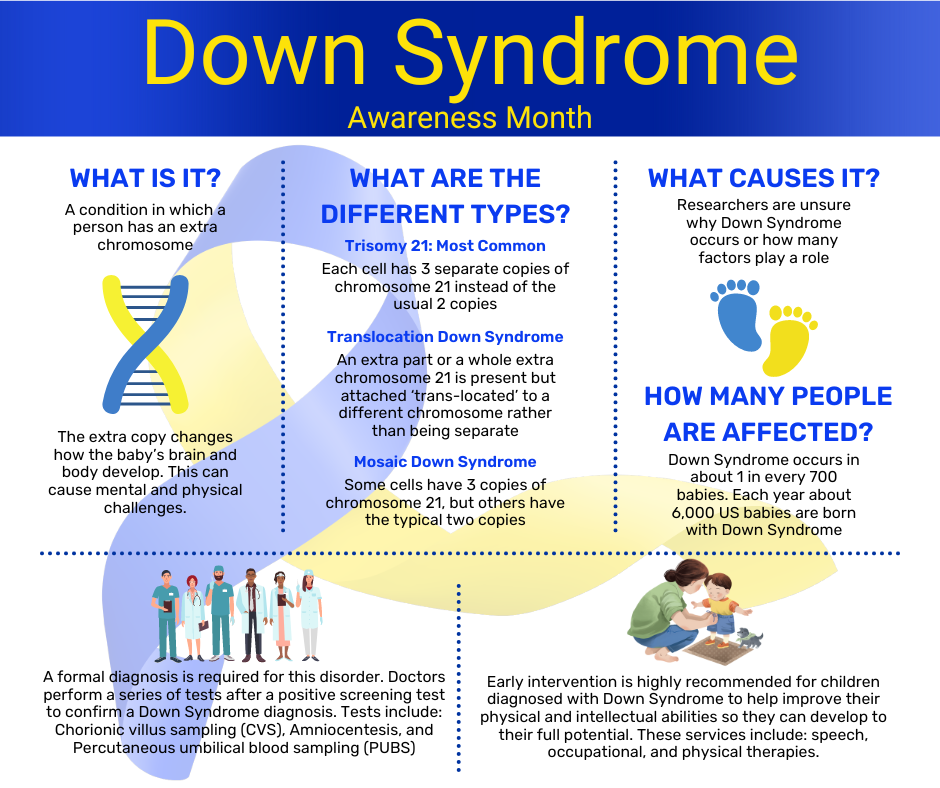Physical therapy
Encouraging Crawling: Tips for a Strong Start
March 28, 2024Once your baby starts showing interest in being mobile you might be tempted to rush them through the crawling stage and start to encourage them to get up and moving on their feet, but our physical therapists recommend not rushing this important milestone and instead encouraging the crawling stage as it provides your kiddo with so many benefits you may not have considered.
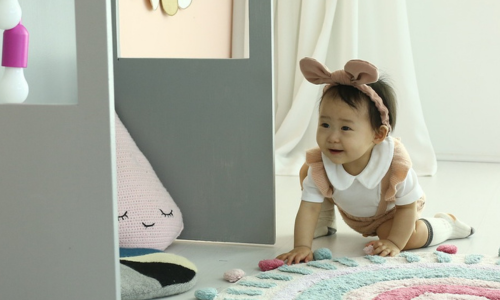
Walking takes strength, why does my baby need to crawl before they walk to develop their strength?
It’s true that learning to walk will require your baby to build their leg strength, but what about all the arm strengthening they’re missing out on by not crawling first? Crawling is not only the first time your baby puts significant weight on their hands, wrists, arms, and shoulders, but also the longest amount of time they’ll spend developing these muscles. Muscles that will later be used to feed themselves, play with toys, color, and dress themselves. The muscles in their legs and core will also strengthen during this time, which will make transitioning to walking even easier.
You need postural control to walk, why can’t my baby learn both at the same time?
While your baby could learn postural control while they tackle the task of learning to walk, crawling will provide them with more stability and practice while they gain the postural control skills required to walk properly. Crawling requires your baby to engage their core muscles to support their body weight which is essential for maintaining an upright posture when standing and walking.
Since my baby has great hand-eye coordination when sitting and playing with toys, why do they need to crawl before they walk?
Good hand-eye coordination is an important skill for babies to learn, but coordination of their limbs is necessary for crawling, walking, and more advanced movements. Crawling encourages babies to learn how to simultaneously move their arms and legs in a coordinated manner, which helps control their balance, which in turn improves their ability to maintain appropriate posture when they eventually begin to walk.
My baby recognizes themselves in the mirror and engages appropriately with their play mats and stacking toys, what more awareness and motor planning do they need to walk?
Crawling helps babies establish their body awareness within space safely, so that they can learn how to maneuver around their environment with minimal risk. It helps to teach them an understanding of their own movement, and helps enhance their depth perception, so that when they begin walking, they will be less likely to trip, fall, or run into things.
My baby gathers information about their surroundings whether they’re in a highchair, on a playmat, or in my arms, doesn’t that make them ready to walk?
Some of the most important information gathering and processing skills that your baby gains through crawling are done by sensory exploration and multisensory integration. Crawling allows babies to explore their environment through touch, sight, and sound. While they touch different surfaces and textures, they are learning to integrate this sensory information with their motor planning to adapt to various terrains and surfaces as they grow.
Tips for Encouraging Crawling
- Practice tummy time early and often.
- Use play mats and play gyms.
- Create a safe and open space for exploration.
- Babyproof their environment.
- Focus on floor-based activities.
- Invest in crawl through tunnels.
- Avoid walkers and exersaucers.
- Offer motivating toys.
- Provide interaction and praise.
- Be patient.
Author’s Note:
The valuable insights and information shared in this article were provided by the Schreiber Center for Pediatric Development’s pediatric physical therapist Rachel D’Arcy. Rachel’s extensive knowledge and experience in pediatric physical therapy was instrumental in crafting the content of this piece.
As a nationally recognized pediatric facility, the Schreiber Center for Pediatric Development provides family-centered education and therapy programs for infants, children and adolescents with disabilities, developmental delays, and acquired injuries. Our goal-oriented approach maximizes each child’s ability to function independently within the community.
General Monthly eNewsletter Sign Up
Sign up to receive monthly newsletters to your email box to learn more about what is going on at the Schreiber Center, and how you can help support our mission to help every child in need reach their fullest potential.
2024 Schreiber Ambassadors Announced at the 40th Annual Schreiber Gala!
March 18, 2024Every year we choose a few lucky kiddos to be Ambassadors of our mission. To join us as special guests at our events. To share their stories with our families and friends. To highlight the life-changing services our therapists are providing every day to those who need them most. This year we’re proud to announce that we have four amazing kiddos serving as Schreiber Ambassadors.
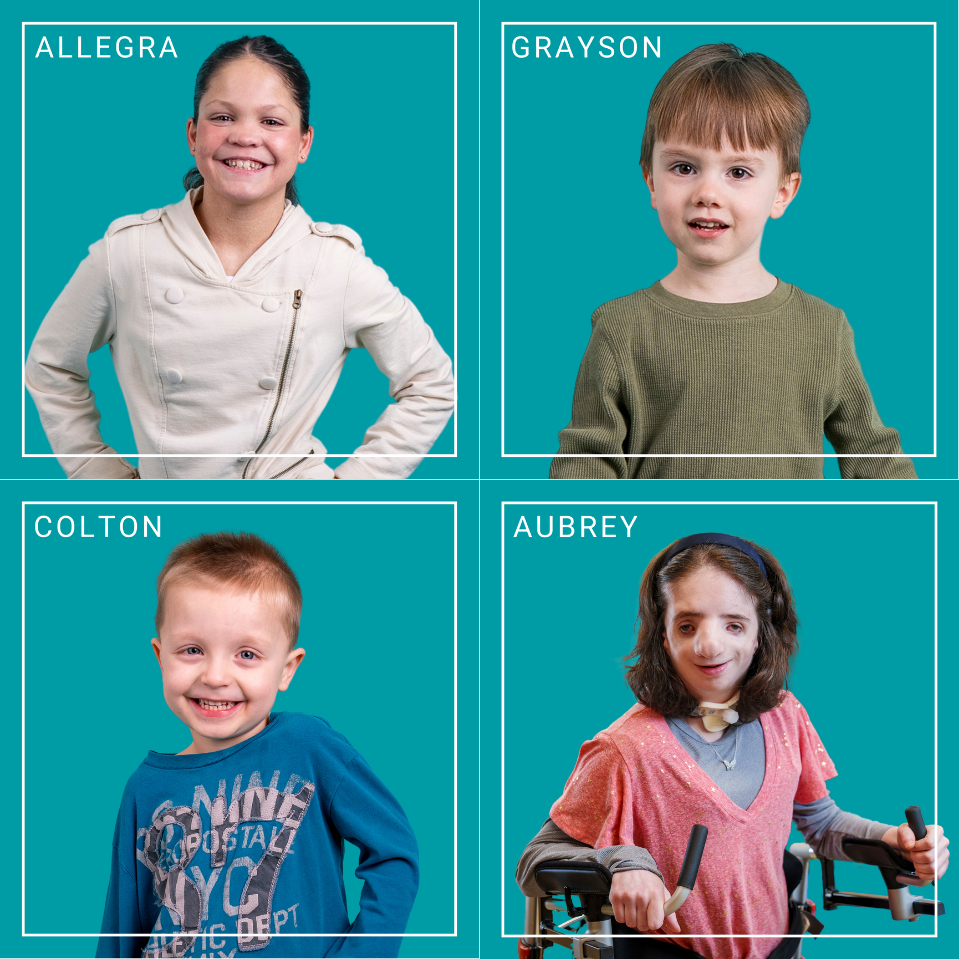
From oldest to youngest, we’d like to now introduce you to our 2024 Ambassadors, Aubrey Jacoby, Allegra Essis, Colton Kiss, and Grayson Smith.
Aubrey Jacoby
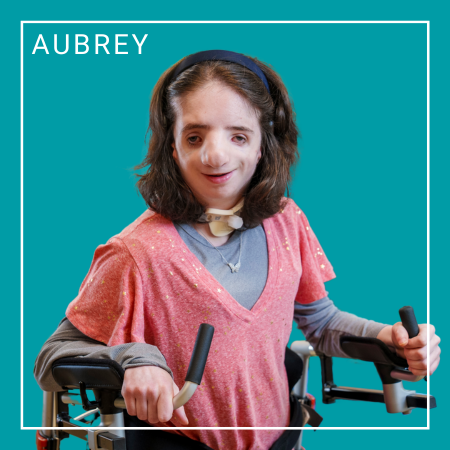
Aubrey is an 18-year-old, senior in high school, with a passion for video editing and a love of music. She has been a Schreiber client since she was three years old, when she began therapy sessions to counteract the physical effects of her cerebral palsy diagnosis. Through physical therapy and occupational therapy sessions Aubrey has gained and sustained both gross and fine motor skills that help her navigate through life as independently as possible.
Aubrey has undergone over 80 surgeries in her lifetime to combat difficulties associated with her diagnoses of both cerebral palsy and Treacher Collins syndrome. Because she had difficulty breathing one of these surgeries was to insert a tracheostomy tube, creating an opening in her trachea from the outside of the neck to help oxygen reach her lungs. She began speech therapy at Schreiber after that surgery and re-learned how to speak with the trach and use an augmentative and alternative communication (AAC) device to communicate with the world and has since graduated from speech therapy. Just like most 18-year-olds she’s excited to graduate from high school next, and start working on building a career for herself.
Allegra Essis
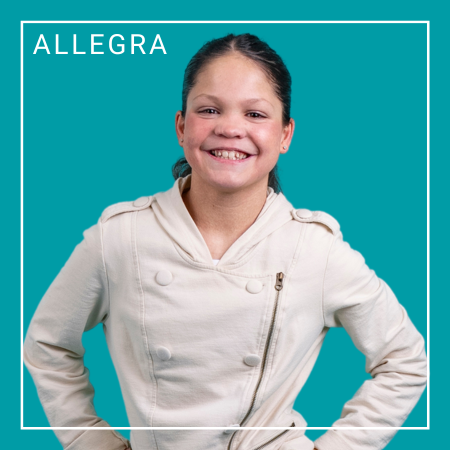
Allegra is 13 years old and in her last year of middle school, where she is a social butterfly with a flair for theater. When she was just an infant her parents enrolled her in early intervention therapy care to combat challenges she was facing with her gross motor skills. At five years old she was diagnosed with cerebral palsy and has been a frequent flyer at Schreiber for physical therapy ever since. During her time at Schreiber sha has gained a lot of core strength, flexibility, balance, and of course confidence which all help her pursue her interests in dance, horseback riding, and skiing.
Early on, Allegra had difficulties standing up, walking, running, balancing, and using stairs. Her parents’ initial goals were for her to gain the strength and balance needed to walk independently. She was fitted for orthotics to help stabilize her gait and help her do these activities, which she continues to use today. A recent surgery on her hamstrings set back her progress slightly when it left her wheelchair bound for a time. Through dedicated physical therapy sessions at Schreiber three times per week, she is now back to her normal, walking independently and participating in her many activities.
Colton Kiss
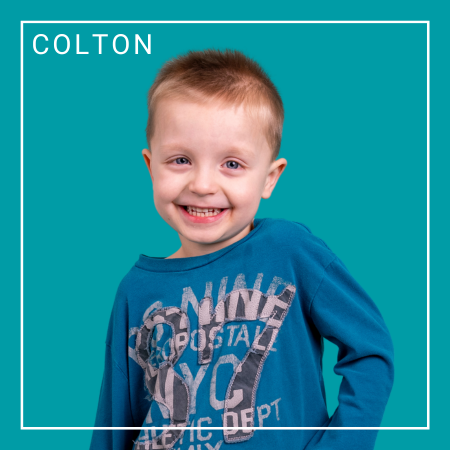
Colton is almost four years old, and attends our Circle of Friends Academy preschool, where he enjoys learning and playing with his friends. He has attended therapy at the Schreiber center for three years, after a complication at birth resulted in four brain hemorrhages as well as a blood clot on his cerebellum that caused permanent damage. Shortly after he was born his mom was told by doctors that he may never walk or talk due to the damage done. His mom was familiar with Schreiber and knew that our center was his best chance at beating those odds.
He currently participates in all four of our offered therapies, physical, occupational, speech, and behavioral health to help him combat the challenges of his diagnosis. Please who have known Colton through his entire journey have witnessed the miracle of his transformation. And people who meet Colton today would never believe that there was ever a chance that he may have never learned to walk or talk. His physical therapy sessions have helped him build core strength and balance needed to sit, stand, and walk on his own. Occupational therapy has helped him develop the coordination and focus needed to perform self-care tasks like dressing himself and feeding himself. Speech therapy has given him the ability to communicate his wants and needs with those around him. And behavioral health therapy has taught him how to communicate those wants and needs more appropriately.
Grayson Smith
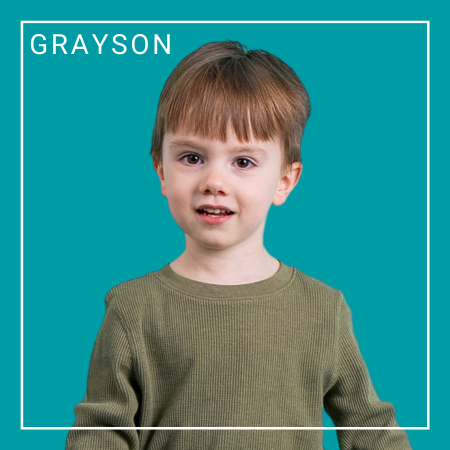
Grayson is three years old and has attended therapy at Schreiber since he was just nine months old. First for physical therapy to address a diagnosis of low tone, where he built the strength and coordination required to sit, stand, walk, and run on his own. A year after starting and later graduating from physical therapy he was also diagnosed with level 1 autism. At which time he began speech therapy and occupational therapy to help him gain both physical and social skills.
Once a week, he still comes to the Schreiber center to work on his sensory processing skills, social skills, and self-care tasks in occupational therapy. He uses the skills he learns in therapy every day to express his wants and needs effectively with those around him and navigate through new social situations that would have had him shutting down in the past. Thanks to occupational therapy he is also now able and willing to perform daily self-care tasks on his own and with the help of his parents without a struggle. His parents are confident that the tools he’s learning in therapy will ensure that he is developmentally ready for school in the next few years. His confidence has already grown tremendously as he learns to self-advocate and even initiate new friendships on the playground.


While each of our 2024 ambassadors have been attending therapies at the Schreiber center for a few years, we will be highlighting their progress and achievements on our social media channels this year to allow our friends and supporters to witness firsthand what makes our pediatric therapy center so special. So, make sure to follow us on Facebook and Instagram to watch their stories unfold.
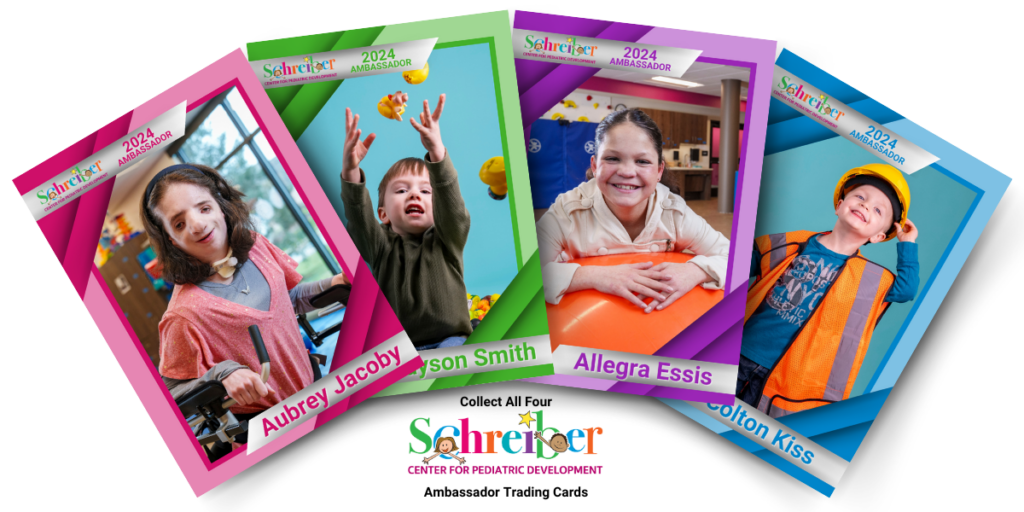
We’ve also made fun collectible trading cards for each of our 2024 ambassadors to hand out to fellow Schreiber families, friends, and supporters during our various fundraising and community events throughout the year. These cards highlight the therapy journey of each ambassador and celebrate how far they have each come. Attend all our events and collect each ambassadors trading card for special keepsake showcasing your support of all Schreiber kids.
Help Schreiber Kids like our Ambassadors receive the care they need, by donating in support of our Kids’ Care Fund, a long and short term savings account used to cover the costs of uncompensated care.
As a nationally recognized pediatric facility, the Schreiber Center for Pediatric Development provides family-centered education and therapy programs for infants, children and adolescents with disabilities, developmental delays, and acquired injuries. Our goal-oriented approach maximizes each child’s ability to function independently within the community.
General Monthly eNewsletter Sign Up
Sign up to receive monthly newsletters to your email box to learn more about what is going on at the Schreiber Center, and how you can help support our mission to help every child in need reach their fullest potential.
Therapists at Schreiber Went Above and Beyond to Help My Son Thrive: A Personal Testimonial
February 27, 2024Written by: Schreiber Client Brayden’s Mom, Alicia Earnesty
Brayden has been attending therapy at Schreiber Center for Pediatric Development for over 5 years now. As a medically complex child, Brayden has many diagnosis and challenges including intractable epilepsy(LGS) and cortical visual impairment. He first began receiving PT, OT, Speech, Feeding and Aqua therapy as we desperately searched for ways to help. He was unable to hold his head up, bare weight, sit up, functional use his hands or share any form of communication.

The amazing therapist at Schreiber immediately began to create a plan. His team has went above and beyond to research, learn other strategies and implement accommodations to help him thrive. The begin years were a true struggle to make progress in the midst of survival mode between hospitalizations and seizures. Covid hit which forced us to pivot to virtual therapy for 2 years working remotely from our basement therapy room. The amazing therapist never gave up and little by little we celebrated Brayden’s inch stones. We celebrated sitting on his own, sit to stand, learning to crawl, standing with support, utilizing both hands, grabbing/holding objects, pointing, saying his first words, making choices and using a communication device. Brayden underwent several brain surgeries over the years and the therapist never skipped a beat to help him rehab, bounce back and make leaps of progress.
Looking back upon all the years of intensive therapy, it brings joyful tears to our eyes as to how far Brayden has come. Today, Brayden is a walking talking miracle and true representation to never give up hope. Brayden can voice, sign and use his adapted communication device to share what he is thinking, needing and even what he doesn’t want. Brayden can now eat foods by mouth and working so hard on independent fine motor skills. Brayden can now independently walk, go up/down stairs, squat to pick up items, and even run!
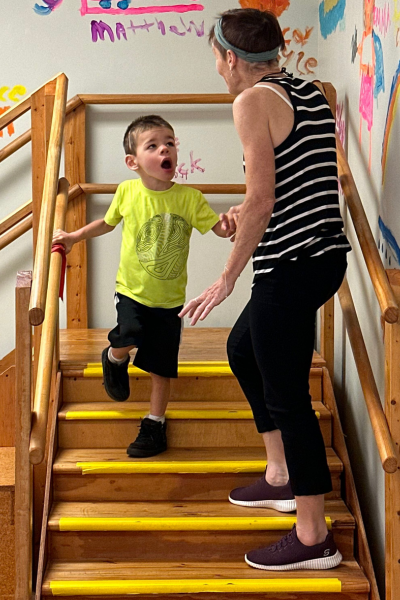
Brayden waves and squeals with excitement on therapy days. We love calling “the duck duck place” (as Brayden calls it) home as Schreiber has become family and we are forever grateful for the staff and therapists. Thank you to Lisa, Maddy, Rebecca, Libby, Deanna, Meghan, Sarah, Christen, Adrian and so many more for your impact on his journey. To other families looking for the supports your child needs, Schreiber is the BEST in the area hands down. Partnering with them and continuing to implement at home, the sky is the limit!
Help Schreiber Clients like Brayden receive the care they need, consider donating in support of our Kids’ Care Fund, a long and short term savings account used to cover the costs of uncompensated care.
As a nationally recognized pediatric facility, the Schreiber Center for Pediatric Development provides family-centered education and therapy programs for infants, children and adolescents with disabilities, developmental delays, and acquired injuries. Our goal-oriented approach maximizes each child’s ability to function independently within the community.
General Monthly eNewsletter Sign Up
Sign up to receive monthly newsletters to your email box to learn more about what is going on at the Schreiber Center, and how you can help support our mission to help every child in need reach their fullest potential.
The Myth and Reality of In-Toeing and Out-Toeing
February 1, 2024Have you ever found yourself marveling at your little one’s unique walking style? Those adorable little toes of theirs pointing inward or outward might seem like a quirky phase they’ll grow out of, but that’s a common misconception. Let’s dive into the myth and reality of in-toeing and out-toeing in kids and why pediatric physical therapy might be just what the doctor ordered.
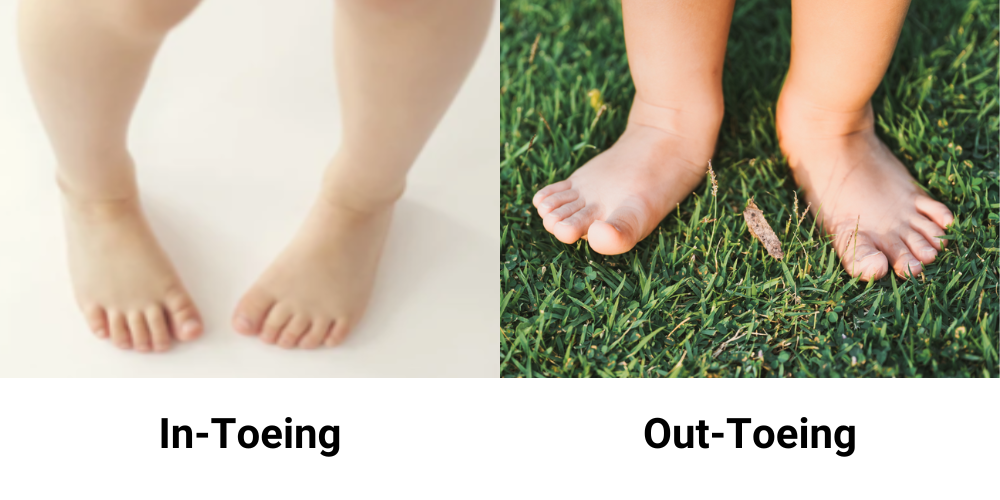
When little ones initially start walking, it is common to see some bowing (bending outwards) at the knees, while maintaining knee and foot alignment. At two years-old, we expect our tiny tots to conquer walking, stairs, and climbing with their feet pointing forward. By three years-old, those little piggies should ideally be in line, meaning their feet should be in line with their knees and tibias. But what happens when the journey takes a zigzag detour?
The easiest way to tell if your child is in-toeing or out-toeing is to watch their feet while they walk. If their feet are not facing forward in a straight line, they may need professional intervention. Another way to determine if they may be exhibiting signs of this is if their legs look like they’re making the letter W while they’re sitting and playing on the floor, or if they’re falling over or losing their balance more often than what seems normal for their age. In all these cases you should ask your pediatrician or primary care provider to make a referral to have their stance and gait reviewed by a pediatric physical therapist to determine if they would benefit from ongoing physical therapist at the Schreiber Center for Pediatric Development to retrain their gait and posture.
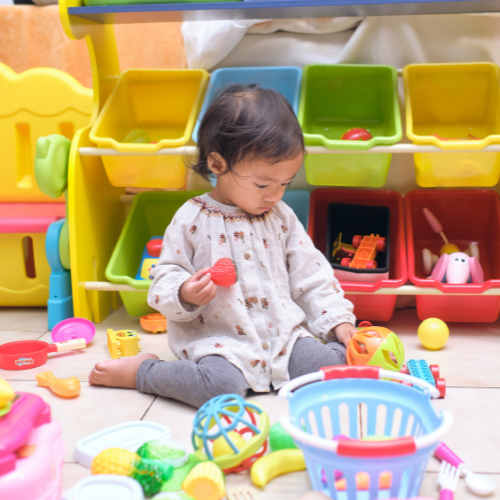
Ignoring in- and out-toeing can lead to several more serious complications. These rotational deviations can cause muscle imbalances, gait inefficiencies, and even osteoarthritis of the knee. While muscle imbalances and gait inefficiencies can be worked on and improved in physical therapy as your child ages, once osteoarthritis of the knee begins, there is no way to reverse it, which is why pediatric physical therapy for in- and out-toeing is so important. Another common issue seen with in-toeing and out-toeing is foot overpronation, which can cause the arches of their tiny feet to flatten more than they normally would, which increases their risk of foot and leg injury. It is critical to address any rotational issues as soon as possible because as children age, it is hard to make changes to their bony structure.

There are another several reasons behind why a child might walk in a in-toe or out-toe style including: w-sitting habits, ligament laxity, pelvic instability, low muscle tone, poor trunk control or femoral rotation, and the solution to them all is pediatric physical therapy. By working with a pediatric physical therapist at the Schreiber Center, kids can work on targeted exercise to strengthen the muscles in the affected areas and learn how to use these strengthened muscles to stand and walk with correct posture promoting neutral alignment. They may also be fitted for orthotics or Togrite Strapping to support their feet and promote proper alignment while they attend physical therapy sessions to improve their balance, coordination, and flexibility.
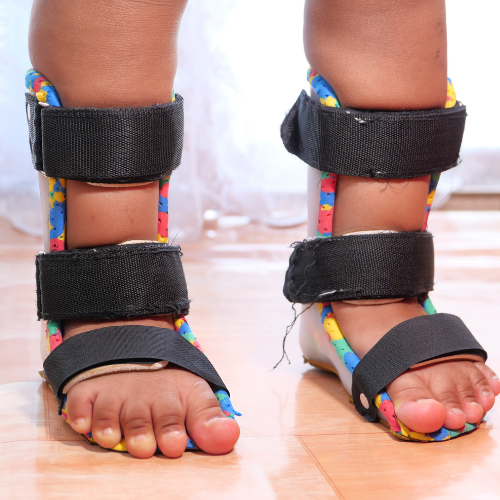
The most important and impactful aspect though, is making sure that in- and out-toeing is caught early, and addressed through pediatric physical therapy as soon as possible. By addressing these concerns as soon as you notice them, you are providing your child with a greater chance to develop healthy posture and gait and minimize the risks of long-term complications associated with in- and out-toeing.
Author’s Note:
The valuable insights and information shared in this article were provided by the Schreiber Center for Pediatric Development’s pediatric physical therapist Rachel D’Arcy. Rachel has a wealth of experience in pediatric physical therapy, and her expertise has been instrumental in crafting the content of this piece.
If you are interested in learning more about how Schreiber’s Pediatric Physical Therapy Services can help your child visit https://www.schreiberpediatric.org/physical-therapy/
As a nationally recognized pediatric facility, the Schreiber Center for Pediatric Development provides family-centered education and therapy programs for infants, children and adolescents with disabilities, developmental delays, and acquired injuries. Our goal-oriented approach maximizes each child’s ability to function independently within the community.
Embracing the Chill: The Many Benefits of Playing in the Snow
January 19, 2024The temperature is dropping, and those beautiful snowflakes are falling from the sky. You might be thinking that you’re stuck inside with the kids until it gets warmer, and that snow starts to melt. But our occupational therapists say it’s the perfect time to bundle up those kiddos and send them outside for some snowy adventures. Playing in the snow offers a ton of benefits for children, from physical activity to sensory awareness. So go ahead and embrace the winter wonderland while it lasts!
Snowcializing through Physical Play
From snowball fights to sledding adventures, each snowy activity becomes a way for your kiddo to connect with others and improve their socialization skills. Not to mention the fact that all that snow is the perfect backdrop for some serious fun physical activity! Whether they’re making snow angels, building igloos, or helping shovel, they’ll be getting in some exercise without even realizing it!

Frost-ivating Creativity and Imagination
Snow play is a great way to stimulate a child’s natural creativity and imagination. Building forts and snowmen are great examples of ways to let their creativity shine. Once the building is done you can even use washable paints and brushes to color and decorate their masterpieces.
Snowmazing Sensory Skills
Snowy terrain is a natural playground that can help kids improve their fine and gross motor skills and even engage their sensory awareness. Using all five senses they can see the snow falling, hear it crunch under their boots, smell the fresh air as it falls, touch it with their hands or feel it under their feet, and even taste the freshly fallen snow. Not to mention the fact that playing in the snow is a WORKOUT, providing deep pressure and heavy work/play which promotes sensory awareness.

SnowGuard: Boosting Immune Systems
Did you know that research shows that children who come into regular contact with dirt, trees, grass, and snow in an outdoor setting are less likely to develop autoimmune disorders and allergies? It’s true. So just by simply being outside in the snow their health is benefiting, not to mention that when the sun shines through those clouds they’ll be getting a much-needed dose of Vitamin D.
Frosty Fun and Positive Flurries
Outdoor snow play is a great way for kids to expend all that pent up energy they have from sitting in a classroom all day. The cold air invigorates them, and the positive interactions they have with friends while playing help to create an exciting and happy atmosphere. A bonus for mom and dad? After playing in the snow kids are more likely to enjoy a long restful night of sleep, setting them up for a happy tomorrow.

Snowpuzzling Problem Solving
Navigating the snowy landscape can be challenging for kids, but with that challenge comes the development of some pretty solid problem-solving skills. From figuring out the best way to build a sturdy snowman, to strategizing the construction of their snow fort, each adventure becomes a playful puzzle. Suddenly their fun snow adventure is a frosty classroom in nature.
Snowlective Language Development
Engaging in snowy escapades can also help improve your child’s language development. Use the new environment to teach and promote new vocabulary related to the weather and play. Whether they’re just starting to form words like cold, soft, hard, and white, or they’re working on their auditory processing skills to practice following more than one direction at a time, playing in the snow can be a tool to improvement. Allow them to build and shape their expressive communication while they work to build and shape their snowy play.

Don’t be afraid of the winter months. Learn to embrace the cold and encourage outdoor play even in the snow. By dressing appropriately and venturing outside, children gain significant sensory information that contributes to their overall well-being. From the cold wind on their faces to the visual tracking of falling snowflakes, every aspect of snow play becomes an exercise in mindfulness. Moreover, it creates common ground for bonding across generations, as everyone can participate in the joy of winter activities. So, let the kids play, explore, and revel in the magical world that snowy days bring. Just don’t forget the gloves!
Author’s Note:
The information shared in this article was provided by the Schreiber Center for Pediatric Development’s occupational therapists Angie Rice and Bernie Hershey. Their extensive knowledge and experience has been essential in shaping the content of this piece.
If you are interested in learning about how Schreiber’s Pediatric Occupational Therapy Services can benefit your child visit http://www.schreiberpediatric.org/behavioral-health/
As a nationally recognized pediatric facility, the Schreiber Center for Pediatric Development provides family-centered education and therapy programs for infants, children and adolescents with disabilities, developmental delays, and acquired injuries. Our goal-oriented approach maximizes each child’s ability to function independently within the community.
OASUS Harness System Takes Pediatric Physical Therapy to New Heights at Schreiber Center
January 18, 2024The new physical therapy gym at the Schreiber Center for Pediatric Development is now open! This state-of-the-art facility is equipped with a range of innovative equipment and open spaces, all meticulously designed to enhance therapy sessions for all our PT patients. This environment allows for more personalized therapy in a warm and inviting atmosphere, filled with natural light, vibrant colors, and a sense of fun. It is particularly welcoming to our young patients, putting them at ease, making them more receptive to therapy, and eager to engage in their rehabilitation.
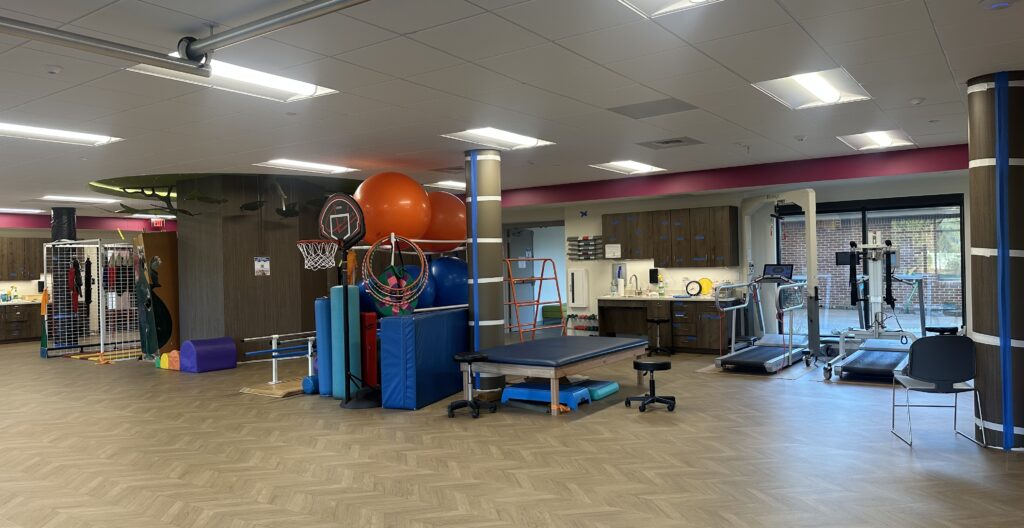
One of the most exciting features of our new gym is the introduction of the OASUS Harness System, a cutting-edge bodyweight support system that takes pediatric physical therapy to the next level. Provided by Enliten LLC, this system offers a flexible and dynamic approach to gait training, enabling our young patients to experience a greater range of motion, including rotational and frontal plane movement. This added versatility is crucial in helping our children develop their motor skills, balance, and coordination. The OASUS system also incorporates bungee cords, encouraging active engagement and fostering independence, thus strengthening their muscles and overall physical development. Furthermore, it simplifies therapists’ work on important milestones like stair climbing.

Our new rock wall adds a fun and challenging element to physical therapy sessions for many of our clients. Climbing the rock wall helps children build strength, coordination, and self-confidence while enjoying the process. Combining engaging activities with therapeutic methods is just one way our physical therapists help children reach goals others didn’t believe possible. We’ve expanded our gym to include new exercise equipment, including stationary bikes, to further this goal.
Safety is a top priority at Schreiber, and we’ve updated our mat tables to provide a comfortable and safe surface for various therapeutic exercises and activities in the new gym. These tables offer enhanced support for our children during stretching and strengthening routines, creating a more conducive environment for their rehabilitation.
“The new gym has provided us with more space and flexibility for personalized therapy. It is very inviting and bright and fun. The several new additions including the OASUS, rock wall, and new mat tables allow us to have even more treatment options to provide the best therapy to the kids that we serve.”
– Laurie Panther, Physical Therapist at the Schreiber Center.
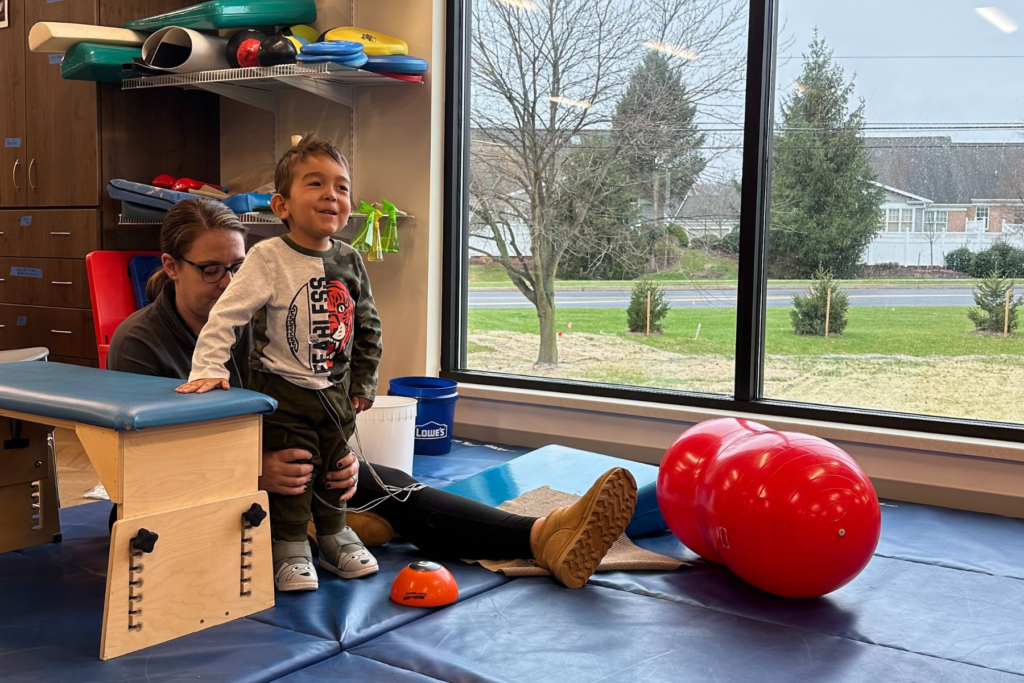
Have you ever seen a tree in the middle of a PT gym? If you’ve had sessions in ours, you have. And soon, we’ll be introducing sensory boards and other vertical play areas to enhance our therapy sessions even further on this tree. These additions will provide opportunities for sensory integration and cognitive development. Just another example of how we’re making therapy not only effective but also enjoyable for our young patients.
While the main gym is complete and open to clients, we are still working on completing extra treatment rooms dedicated to casting and pelvic floor treatments, greatly enhancing the level of care we can offer. These specialized rooms will ensure that our children receive the individualized attention they deserve, with access to the specific therapies they require.
The new physical therapy gym at the Schreiber Center stands as a testament to our commitment to the children and families we serve. We are deeply grateful to our supporters, donors, and partners who have made this space possible. Stay tuned for updates as we continue our renovations throughout the center to bring our clients the most innovative and up-to-date technology and services available. The future is bright at the Schreiber Center, and we can’t wait to share it with you!
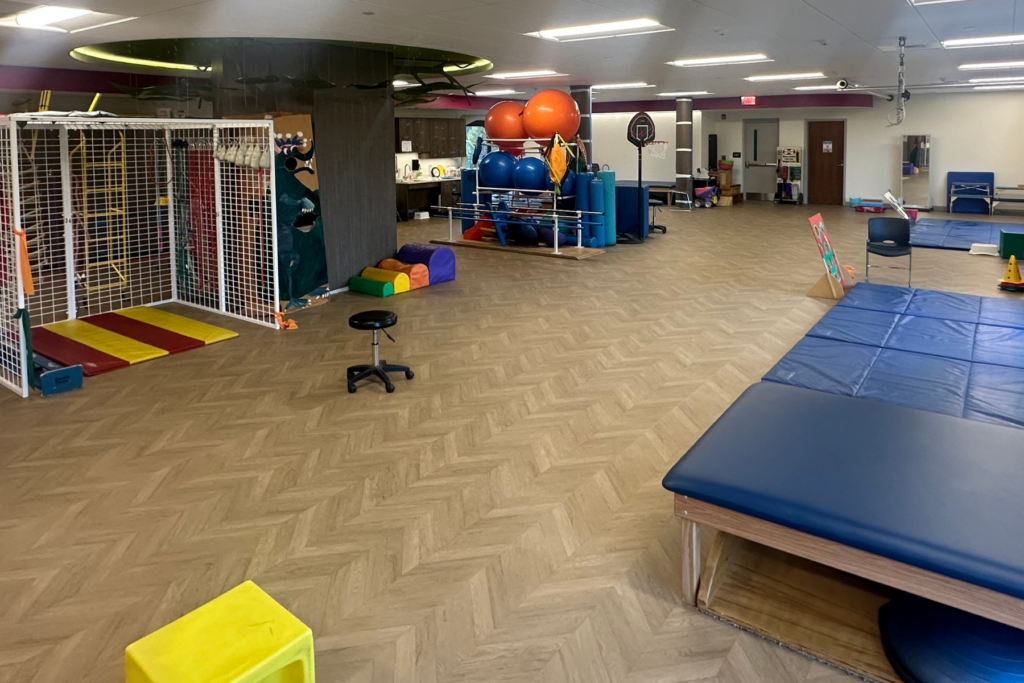
Donate today to help us continue to update and improve our spaces so that we can provide quality care to more children in need.
As a nationally recognized pediatric facility, the Schreiber Center for Pediatric Development provides family-centered education and therapy programs for infants, children and adolescents with disabilities, developmental delays, and acquired injuries. Our goal-oriented approach maximizes each child’s ability to function independently within the community.
Thank You to our 2023 Ambassadors!
December 31, 2023As we reflect on 2023, we are filled with gratitude for the amazing kids and families who have allowed us to spotlight their journeys through our therapy services, the true champions of our mission – our 2023 Schreiber Ambassadors!

It is through your tireless efforts that you’ve helped spread awareness about the vital work we do at Schreiber. Your advocacy has not only shone a spotlight on the challenges faced by those we serve but has also illuminated the pathways to hope and healing that our organization provides.
Your participation in our fundraising initiatives has been nothing short of extraordinary. By leveraging your networks and utilizing your influential voices, you’ve helped reach and exceed our goals all year so that we can continue making a meaningful difference in the lives of all #SchreiberKids. Your commitment to the betterment of our community is not only commendable, but also deeply appreciated.
As we express our gratitude, we also want to acknowledge the impact you’ve had on fostering a sense of community and belonging within the Schreiber family. Your enthusiasm has resonated with others, creating a ripple effect that strengthens the bonds of support and solidarity among those who share a connection to our organization.
In recognition of your exceptional contributions, we want to express our deepest appreciation. Your willingness to be ambassadors for Schreiber has not only elevated our mission but has also touched the hearts of those who have had the privilege of hearing your stories.
Thank you, 2023 Schreiber Ambassadors, for everything you’ve done to support our mission this year!
Support the therapy and education of our current and future Schreiber kids by donating to our Kids’ Care Fund today!
As a nationally recognized pediatric facility, the Schreiber Center for Pediatric Development provides family-centered education and therapy programs for infants, children and adolescents with disabilities, developmental delays, and acquired injuries. Our goal-oriented approach maximizes each child’s ability to function independently within the community.
ExtraGive Funds Pediatric Therapy at Schreiber
October 31, 2023Every child deserves the opportunity to lead a healthy and fulfilling life. At the Schreiber Center for Pediatric Development, we are committed to ensuring that every child, regardless of their abilities or financial circumstances, has access to the quality care they need.

The ExtraGive event (https://www.extragive.org/) is a remarkable opportunity for us to come together as a community and make a significant impact on the lives of children who rely on our pediatric therapy programs. Your generous donations during the ExtraGive event will directly benefit our occupational, physical, speech, and mental and behavioral health therapy programs, as well as our “Kids’ Care Fund” designed to cover uncompensated care expenses.
Pediatric Occupational Therapy: Feeding Program
Pediatric occupational therapy is a crucial component of the services we provide at Schreiber Center for Pediatric Development. Many children face challenges related to feeding and nutrition, and our goal is to support them in developing the necessary skills for a healthy diet. Your donations will help us establish a new feeding program that will provide personalized support to children with various feeding difficulties.
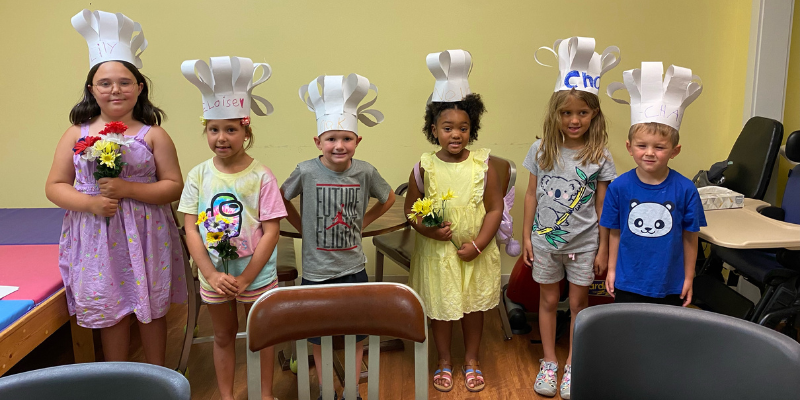
Feeding issues can be a source of tremendous stress for families, and your contributions will make it possible for us to offer specialized therapy, equipment, and resources to help these children develop the skills they need to thrive.
Pediatric Physical Therapy: Medical Mobility Equipment

Children with mobility impairments often require specialized equipment to enhance their mobility and independence. The funds donated during the ExtraGive event will be instrumental in acquiring essential medical mobility equipment for our pediatric physical therapy program.
These devices can be life-changing for children, enabling them to participate in everyday activities and improving their overall quality of life. Your support will help us ensure that no child in central PA is left without the necessary equipment to navigate the world around them.
Pediatric Speech Therapy: Communication Devices
Communication is a fundamental aspect of a child’s development, and for some children, it can be particularly challenging. Our pediatric speech therapy program is dedicated to helping children develop their communication skills, and your donations will play a pivotal role in achieving this goal.
We aim to provide augmentative and alternative communication (AAC) devices, speech-generating devices (SGDs), and other assistive communication tools to children who need them. These devices empower children to express themselves, connect with others, and engage with the world in meaningful ways.

Mental and Behavioral Health Therapy: After-School Social Programs
At Schreiber Center for Pediatric Development, we recognize the importance of mental and behavioral health in a child’s overall well-being. Your donations will support our after-school social programs, including the popular “After-School Lego Club,” designed specifically for children with autism.
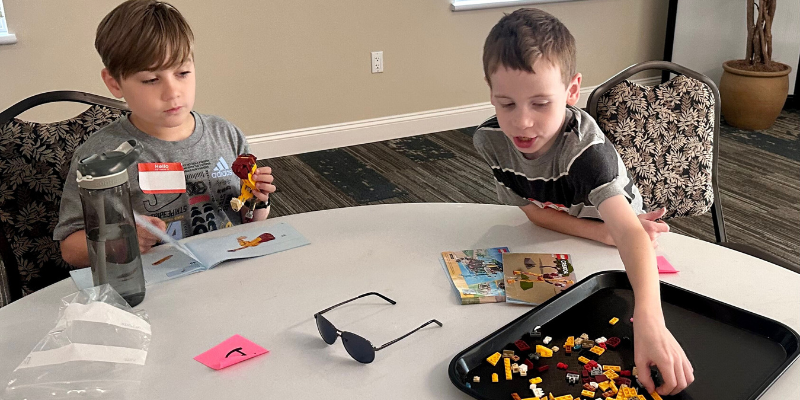
These programs offer a safe and supportive environment where children can develop social skills, build friendships, and gain confidence. Your contributions will enable us to expand these programs, reaching even more children who can benefit from them.
The “Kids’ Care Fund”: Ensuring Access to Care for All
In addition to directly supporting our therapy programs, your generous donations during the ExtraGive event will be added to our “Kids’ Care Fund.” This fund serves as a safety net, ensuring that all disabled children receive the care they need, regardless of their families’ financial circumstances.
The “Kids’ Care Fund” is a savings account that bridges the gap between what private insurance and Medicaid supplements cover and the actual cost of care. At Schreiber Pediatric, we have always made the promise that no child will be turned away, and your contributions help us fulfill this commitment.

Your support during the ExtraGive event will have a profound and lasting impact on the lives of the children we serve through our pediatric therapy programs at Schreiber Center for Pediatric Development. Whether it’s helping a child improve their feeding skills, providing essential mobility equipment, enabling communication, or fostering social connections, your generosity makes it all possible.
Furthermore, your donations will contribute to the “Kids’ Care Fund,” ensuring that no child is denied the care they deserve due to financial constraints. Together, we can make a difference in the lives of Schreiber kids and their families, offering hope, support, and a brighter future. Join us in transforming lives and creating a more inclusive and compassionate community for all children in central PA. Donate during the ExtraGive event and be a part of something truly extraordinary.
Go Big or Go Home: Javion Rodriguez
October 25, 2023“Go Big or Go Home” says Schreiber client, Javion Rodriguez, who went big this summer when he played in the Little League World Series Challenger Series. For 30 years this series for kids and teens with physical or mental disabilities has invited the best teams in the world to compete, and for the very first time a local team from Lancaster, PA received the invitation.

As one of the older members of the Lancaster PA team Javion says he feels like a role model and leader amongst the team and takes his position seriously. There is part of him that can’t wait to play in the senior league and really show the world what he’s capable of though. When asked what his favorite part of the game was, he had a difficult time choosing his time at shortstop or batting. He settled on the excitement of batting when he recalled his favorite part of the LLWS game was when he was walking to the plate for his at bat and received a standing ovation from the crowd.

In the off season, Javion works on his fielding skills and hitting off a T in his yard at home. During his physical therapy sessions here at Schreiber he prefers to work on specific exercises that will help strengthen the muscles needed to improve his game. Strengthening his core and improving his stance and swing are his personal physical therapy goals right now. Under instruction and supervision of his therapists here at Schreiber, Javion uses weights during rotation exercises designed to strengthen his obliques and performs a modified foam roller plank to strengthen his arms, legs, and core all while working on improving his coordination.

His passion for all things sports has helped him secure his current job as a sports analyst, interviewing and reporting on players, writing articles, and even doing a bit of marketing for a local ‘backyard’ baseball league. Currently a Freshman at McCaskey with straight A’s and an interest in math, Javion plans to graduate high school, go to college and play baseball in the Challenger League for as long as he remains a student. We have no doubt Javion Rodriguez will always “Go Big”!

To help Schreiber Clients like Javion continue to receive the care they need, consider donating in support of our uncompensated care fund.
As a nationally recognized pediatric facility, the Schreiber Center for Pediatric Development provides family-centered education and therapy programs for infants, children and adolescents with disabilities, developmental delays, and acquired injuries. Our goal-oriented approach maximizes each child’s ability to function independently within the community.
Down Syndrome Awareness Month
October 16, 2023This month we have the opportunity to raise public awareness about the condition Down Syndrome, as we advocate for the inclusion and acceptance of people with Down Syndrome. It is an unfortunate fact that people with Down Syndrome continue to face stereotypes and misconceptions about their abilities. We urge you to take this month to learn more about this condition and help us to spread the message of acceptance and respect for all people with Down Syndrome all year round.
What is Down Syndrome?
Down Syndrome is a genetic condition that occurs when a person is born with an extra chromosome. People are typically born with 46 chromosomes, but a person with Down Syndrome has an extra copy or part of an extra copy or chromosome 21.
There are three different types of Down Syndrome, and they are all dependent on how the extra chromosome 21 presents within the diagnosed person.
The most common type of Down Syndrome is called Trisomy 21, and about 95% of people who are diagnosed with Down Syndrome are diagnosed with this type. Trisomy 21 means that each cell within the body has three copies of chromosome 21 instead of the usual two copies.
The second most common type of Down Syndrome is called Translocation Down Syndrome and only about 3% of people diagnosed with Down Syndrome have this type. Translocation Down Syndrome occurs when an extra part or a whole extra chromosome 21 is present but attached ‘trans-located’ to a different chromosome, rather than being separate as is the case of Trisomy 21.
The least common type of Down Syndrome is called Mosaic Down Syndrome and only 2% of people who are diagnosed with Down Syndrome have this type. Mosaic Down Syndrome means that some of the cells in the body have three copies of chromosome 21, but other cells in the body still only have the typical two copies. Because only some of the cells in the body contain this additional chromosome this type of Down Syndrome presents less dominantly in physical features than the other two.
How do I know if my child has Down Syndrome?
About 6,000 babies are born with Down Syndrome in the US every year: that’s about 1 in every 700 babies. Down Syndrome can be detected in utero with screening tests and/or diagnostic tests. Screening tests can tell you if your pregnancy has a higher or lower chance of resulting in a baby with Down Syndrome, but they do not provide an absolute diagnosis. Diagnostic tests on the other hand, can typically detect whether a baby will have Down Syndrome. Diagnostic tests can be risky and are not generally performed until after a positive screening test. They include Chorionic villus sampling (CVS) which examines the material from the placenta, Amniocentesis which examines the amniotic fluid, and Percutaneous umbilical blood sampling (PUBS) which examines the blood from the umbilical cord. Each of these tests look for changes in the chromosomes that would indicate a Down Syndrome diagnosis.
What causes Down Syndrome?
Researchers know that Down Syndrome occurs when a person is born with an extra chromosome 21, but they are unsure how or why the extra chromosome forms. Many researchers believe that there are several different factors that play a role in whether the extra chromosome 21 will form in utero, but they are not entirely sure what those factors are. It is known that the likelihood of a baby being born with Down Syndrome increases with a mother’s age, but because more women give birth before they turn 35, more babies with Down Syndrome are born to women under 35 years of age. Nothing that a parent does during pregnancy is known to cause Down Syndrome.
What are the complications of Down Syndrome?
About half of people with Down Syndrome also have a congenital heart defect. They are also more prone to hearing loss, ear infections, obstructive sleep apnea, respiratory issues, eye diseases, poor eyesight, Alzhemer’s disease, leukemia, thyroid disorders and intestinal blockages at birth that require surgery.
In addition to the physical complications that can come along with Down Syndrome, it can also cause intellectual and developmental symptoms that can lead to cognitive impairment. Similar to the physical complications these symptoms can range from mild to moderate and include short attention span, poor judgement, impulsive behavior, slow learning, and delayed language and speech development.
What is the treatment for Down Syndrome?
Making sure that a child with Down Syndrome receives services early in life will help them to improve their physical and intellectual abilities and ensure that they reach their full potential into adulthood. Most of the services recommended for children with Down Syndrome focus specifically on helping them minimize the effects of any intellectual or developmental symptoms the condition is responsible for. Early intervention services include speech therapy, occupational therapy, and physical therapy.
These therapies can be beneficial to children with Down Syndrome past the years of early intervention as well. Each person with Down Syndrome has different talents, and they all have the ability to thrive. Down Syndrome is a lifelong condition and children with Down Syndrome may need extra help or attention in school, but with the proper treatment plan and early intervention many people with Down Syndrome are able to be mainstreamed and attend regular classes with their peers.
If you child has been diagnosed with Down Syndrome and you are interested in learning more about how Schreiber’s Pediatric Therapies can help your child visit: http://www.schreiberpediatric.org/therapy-services/
As a nationally recognized pediatric facility, the Schreiber Center for Pediatric Development provides family-centered education and therapy programs for infants, children and adolescents with disabilities, developmental delays, and acquired injuries. Our goal-oriented approach maximizes each child’s ability to function independently within the community.
